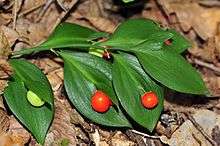Ruscus
| Ruscus | |
|---|---|
 | |
| Ruscus aculeatus | |
| Scientific classification | |
| Kingdom: | Plantae |
| Clade: | Angiosperms |
| Clade: | Monocots |
| Order: | Asparagales |
| Family: | Asparagaceae |
| Subfamily: | Nolinoideae |
| Genus: | Ruscus L. |
| Synonyms[1] | |
| |
Ruscus is a genus of six species of flowering plants, native to western and southern Europe (north to southern England), Macaronesia, northwest Africa, and southwestern Asia east to the Caucasus.[1] In the APG III classification system, it is placed in the family Asparagaceae, subfamily Nolinoideae (formerly the family Ruscaceae).[2] Like many lilioid monocots, it was formerly classified in the family Liliaceae.
The species are evergreen shrub-like perennial plants, growing to 1 m tall (rarely 1.2 m). They have branched stems, bearing numerous cladodes (flattened, leaf-like stem tissue also known as phylloclades) 2–18 cm long and 1–8 cm broad. The true leaves are minute, scale-like and non-photosynthetic. The flowers are small, white with a dark violet centre, and situated on the middle of the cladodes. The fruit is a red berry 5–10 mm diameter. Some species are monoecious while others are dioecious.
Ruscus is spread by seed and by means of underground rhizomes and it can colonise extensive patches of ground.
Species
- Ruscus aculeatus (butcher's broom). Europe, Azores.
- Ruscus colchicus. Caucasus.
- Ruscus hypoglossum. Central and Southeast Europe, Turkey.
- Ruscus hypophyllum (spineless butcher's broom). Iberia, northwest Africa. Used in the floral trade as foliage.
- Ruscus hyrcanus Woronow An endemic and relict bush in the Talish Mountains, Azerbaijan. Protected in the Hirkan national Park.
- Ruscus microglossus. Southern Europe.
- Ruscus streptophyllus. Madeira.[3]
References
- 1 2 Kew World Checklist of Selected Plant Families
- ↑ Chase, M.W.; Reveal, J.L. & Fay, M.F. (2009), "A subfamilial classification for the expanded asparagalean families Amaryllidaceae, Asparagaceae and Xanthorrhoeaceae", Botanical Journal of the Linnean Society, 161 (2): 132–136, doi:10.1111/j.1095-8339.2009.00999.x
- ↑ P. F. Yeo (1966). "Two New Species of Ruscus (Liliaceae)". Feddes Repertorium. 73 (1): 17–20. doi:10.1002/fedr.19660730103.
